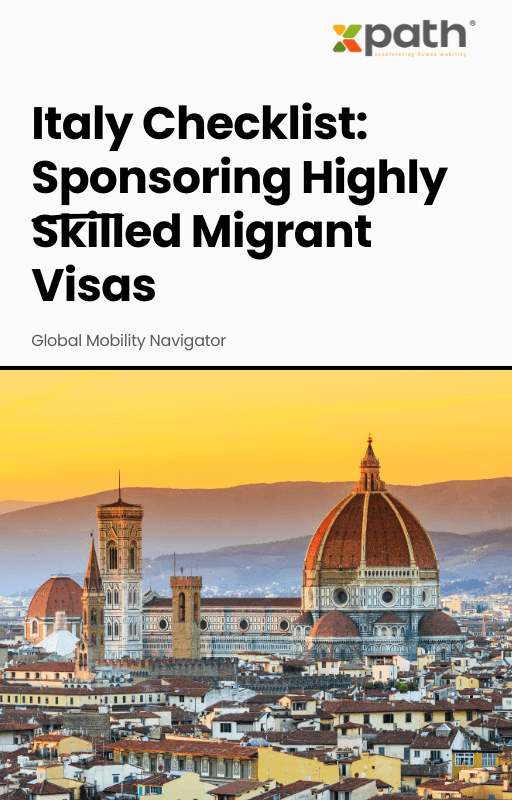Italy Checklist: Sponsoring Highly Skilled Migrant Visas
Grab a copy of a guide to international employee relocation
View E-bookIn today’s fast-paced global economy, businesses are increasingly focusing on global mobility to harness talent and drive growth. However, managing the costs associated with global mobility can be challenging. To address this, it is essential to explore alternative benefits that balance costs while ensuring employee satisfaction and productivity.
The cost of global mobility encompasses several aspects including relocation expenses, housing allowances, tax equalization, and cost of living adjustments. These costs can accumulate quickly, especially when dealing with multiple expatriate assignments. Therefore, companies must identify strategies that optimize expenditures without compromising the quality of the mobility experience.
One effective strategy is to tailor relocation packages to the specific needs of employees. This personalization can include offering lump-sum payments rather than fixed allowances, enabling employees to manage their own expenses according to their preferences. Additionally, providing digital relocation support through apps and online platforms can streamline the process and reduce administrative costs.
Engaging with local resources and services can also significantly cut costs. For instance, partnering with local real estate agents or housing companies can result in better rates for accommodation. Moreover, establishing relationships with local service providers for utilities, transportation, and other essentials can lead to cost-effective solutions that benefit both the company and the expatriate.
Encouraging remote work is another powerful tool for managing global mobility costs. By allowing employees to work remotely, companies can reduce the need for physical relocation. This not only saves on relocation expenses but also enhances work-life balance, leading to higher employee satisfaction and retention.
Implementing hybrid work models, where employees split their time between their home country and the host country, can also be beneficial. This approach minimizes the duration of costly expatriate assignments while still enabling employees to immerse themselves in the host country’s work culture and establish necessary professional relationships.
Tax equalization policies are crucial in ensuring that employees are not disadvantaged by differing tax regimes. By carefully planning and managing tax equalization, companies can avoid unnecessary expenses. This involves thorough understanding of international tax laws and employing tax optimization strategies to benefit both the organization and the employee.
Many countries offer tax incentives to attract foreign talent. Companies should research and utilize these incentives to offset mobility costs. Engaging with local tax advisors can provide insights into available benefits and ensure compliance with local regulations, further optimizing cost management.
Adopting Local Plus compensation packages, which blend local salary structures with additional expatriate benefits, can be a cost-effective alternative to traditional expatriate packages. These packages often include housing, education allowances, and healthcare benefits tailored to the local market, thereby reducing overall compensation costs while maintaining a competitive edge.
Implementing performance-based incentives instead of fixed expatriate allowances can also balance costs effectively. By linking incentives to specific performance metrics, companies can ensure that they are getting the desired return on investment from their global mobility programs. This approach also motivates employees to achieve their goals, fostering a culture of excellence and accountability.
Leveraging technology to manage global mobility programs can lead to significant cost savings. Implementing mobility management software allows for efficient tracking of expenses, compliance, and performance metrics. Automation of routine tasks such as document filling, expense reporting, and employee profile checks can also reduce administrative burdens and associated costs.
Forming strategic partnerships with other corporations can provide mutual benefits in managing global mobility costs. By collaborating on shared services such as relocation logistics, housing, and transportation, companies can achieve economies of scale and reduce individual costs.
Working with governments and non-governmental organizations (NGOs) can also yield financial benefits. Governments often have programs designed to attract foreign talent, which can include financial incentives and support services. NGOs can provide valuable resources and networks to assist with the integration of expatriates into local communities.
Balancing costs for global mobility requires a multifaceted approach that includes optimizing relocation packages, leveraging technology, forming strategic partnerships, and implementing sustainable practices. By exploring and adopting these alternative benefits, companies can effectively manage expenses while ensuring that their global mobility programs remain attractive and competitive. The key is to remain adaptable and proactive in identifying cost-saving opportunities that align with the organization’s overall goals and employee well-being.

Italy Checklist: Sponsoring Highly Skilled Migrant Visas
Grab a copy of a guide to international employee relocation
View E-book